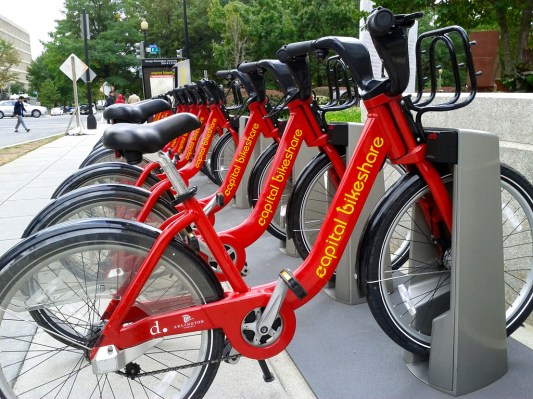As the North American Bikeshare Association begins its annual conference in Austin, Texas, participants will be focusing on social equity. If you’re wondering what that means, wonder no more, thanks to a statement from the NABSA’s project manager, Matt Martin: “Social equity in bikeshare means making a healthy and versatile form of transportation accessible to those who really need it, from students on a budget to mothers in low-income communities.”
I also spoke with the organization’s president at length about bikesharing and how it fits into a changing transportation landscape. “Many people that use bikeshare are people commuting in multiple ways,” she said. “They take the train and bus and then hop on a bike in the end. It’s so convenient and cost effective, and people are using it for practical reasons.”
Bikesharing has been popular in European countries for decades, but now more North American cities are seeing racks of shared bikes at busy intersections. There are dozens of US cities with bikeshare programs, including Portland’s new Nike-sponsored Biketown system, Ford’s sponsorship of expanding bikeshare availability in San Francisco, and Washington DC’s Capital Bikeshare.
“It’s proven successful in almost 100 cities at this point,” Freedman said. “We hear a lot about large cities’ [programs], like New York and Chicago. But the reality is many midsized cities have run successful bikeshares.”
There were early attempts at Euro-style bikesharing, but many times bikes were stolen or trashed rather than shared nicely. The difference in these latest systems, Freedman said, is the thing that’s making a difference in almost every aspect of transportation: technology. “What made bikeshare succeed is the same as with Uber and Lyft. There’s a software system with a hardware component and sophisticated software on the back end. You can’t steal a bike; you need a credit card to get access. But technology makes it so easy – just swipe a key or card and you have a bike. With the Portland system, you can use your cell phone.”
She noted that the success of a bikeshare program is different in every city, and even in each community being served. “Is the system reaching people regardless of race, income, and nationality, or is it just serving a slice of the market? As you expand your service area outside the core of the city, you’re going to do that for equity reasons. It’s public transportation. Outside the core, there will be fewer riders per station and per bike, but it’s a public service for the public good.”
Freedman predicts that in the next couple of decades, most people will not be driving, nor will they own their transportation. “People will be mode agnostic,” she went on. “What an individual cares about is getting from point A to point B the fastest way possible, the least expensive way possible, with the most comfortable experience.” Users will mix bikeshare, walking, public transit, and rideshare every week — and maybe even every day.
“You’ll see all of the modes intertwine,” Freedman said. “And that will be made possible by better tech that allows a single payment for all systems.”
